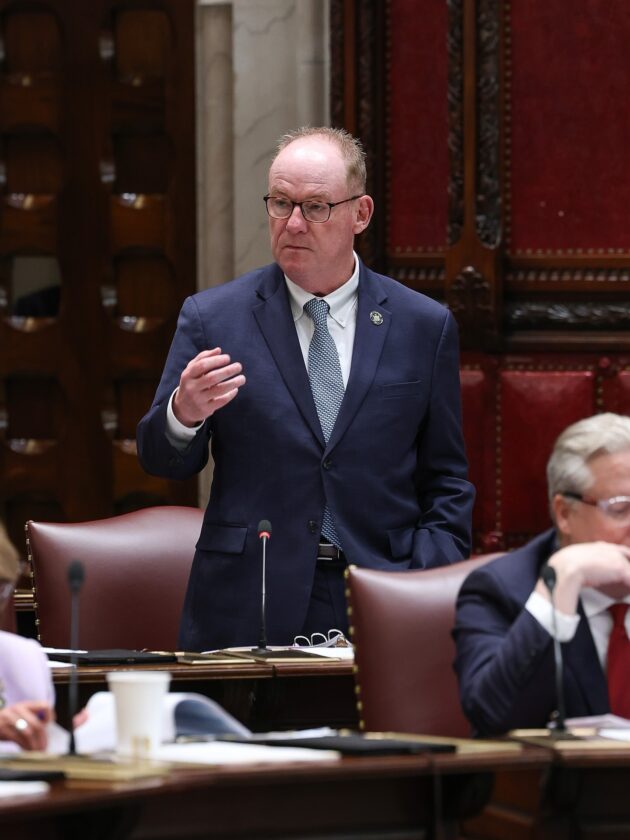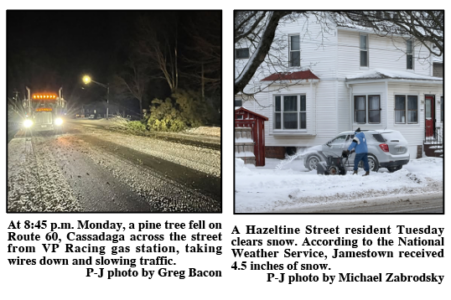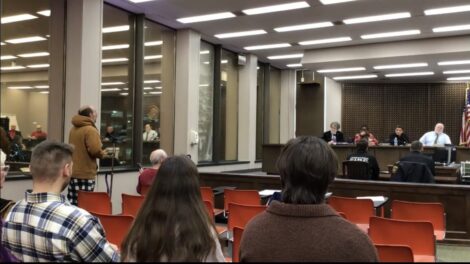Power Prices Prompt Oodles Of Legislation

State Sen. Rob Rolison, R-Poughkeepsie, is pictured speaking on the Senate floor before the end of this year’s legislative session.
Republicans and Democrats in the state Legislature can agree electric prices in New York are too high.
What to do about the issue is the point of contention.
The average price per kilowatt hour of electricity in New York state has increased since 2020 from 17.3 cents per kilowatt hour to 25.67 cents per kilowatt hour in April 2025, the last month the data is available, according to NYSERDA. The average price per kilowatt-hour represents the total bill divided by the kilowatt-hour usage. The total bill is the sum of all items appearing on an electricity bill such as fixed costs, variable rate per kWh, taxes, surcharges, late fees, and even credits for rebates.
Recent data from the U.S. Energy Information Administration show New York households on average pay the sixth-highest price for electricity in the continental United States, according to an Empire Center for Public Policy blog post in June. For March 2025 the average price of electricity in New York was estimated at $0.25 per kWh for residential users and $0.095 per kWh for industrial users. These rates are significantly above the U.S. averages of $0.17 per kWh and $0.08 per kWh, respectively. Households in New York pay 48 percent more, and industry pays 15 percent more than the national average.
State Sen. Rob Rolison, R-Poughkeepsie, recently threw his hat into the electricity cost debate with S.8463, which establish a one-year utility bill tax and surcharge holiday and a two-year green energy tax holiday. The tax- and surcharge-free period would include the gross receipts tax and sales tax as well as system benefits charges, temporary state assessment/incremental state assessment charges and the renewable portfolio standard charges. Rolison also proposes no tariff or surcharge assessed for the construction or implementation of renewable energy systems, electric vehicle ready infrastructure or electric vehicle charging stations may be imposed on a utility ratepayers’ bill for a period of two years.
“These tax and surcharge holidays would provide significant and immediate financial relief to utility ratepayers who are currently experiencing skyrocketing utility bills,” Rolison wrote in his legislative justification. “Government charges, such as taxes and surcharges, account for around 20% of the utility bill.”
There have been several piece of legislation introduced this year aimed at decreasing electric bills or providing greater control over rate hikes, including:
– A.42, which establishes an exemption from taxation for energy-related public utility real property related to attaining state climate goals; provides that such exemption shall remain in effect until it is retired or removed from service.
– A.683, which establishes an emergency heating energy assistance program benefit to provide emergency assistance to certain households where such household is threatened with shut-off or an energy emergency due to nonpayment.
– A. 1126, which would enact the Utility Ratepayer Protection Act to require legislative approval of increases in utility charges.
– A.1270, which requires the notification of a public utility company’s or municipality’s customers when the supply rate increases by at least forty percent and to notify such customers of bill assistance programs by posting on the utility company’s website.
– A.2004, which requires the public service commission hold public hearings on increases in utility rates, fees, rentals, or charges.
– A.2235, which provides for a two percent cap on rate increases imposed by utilities.
– A.2291, which requires public utility authorities to obtain legislative approval before raising rates or fees, or imposing new rates or fees.
– A.2400, which requires consideration of evidence relating to the economic impact of major increases of rates or charges upon consumers and the areas affected by such increases of rates or charges prior to approval of any such rates or charges; establishes minimum data to be considered by the public service commission relating to such economic impact.
– A.4105A, a bill that would establish minimum standards for payment plans for eligible customers and require the public service commission to set standards for payment plans for certain customers including reasonableness of agreements and timelines for payment.
– A.5620, legislation that would establish reduced residential rates for electric and natural gas service to low-income customers.
– A.6152A, the Ratepayer Disclosure and Transparency Act, which would require a monthly report that includes the estimated or actual ratepayer costs and benefits of any mandated state energy program to the governor and legislature including any New York climate leadership and community protection act compliance costs.
A.7021, which would require utility corporations and municipalities to ensure that bills for service to residential customers include a line item for cost impact measures taken in accordance with the climate action council’s final scoping plan; requires the department of public service to establish a formula to enable utility corporations and municipalities to calculate the cost impact on each residential customer’s bill attributed to measures taken in accordance with the climate action council’s final scoping plan.
A. 7542, legislation that would cap public gas corporations, public electric corporations and municipal gas and electric companies at a profit margin of 4% a year.
A.7963, which would eliminate late fees for residential utility customers.
A. 8823, a bill that would establish a usage monitor program for the purposes of notifying customers when energy usage exceeds a cost or usage threshold in a given billing period determined by the customer.
A. 8877, which requires a fiscal note when a bill enacts or amends a law impacting the cost of utility services.
Gov. Kathy Hochul said the state has expanded eligibility in the Energy Affordability Program and created the Energy Affordability Guarantee, a pilot program that ensures low-income New Yorkers participating in the EmPower Plus program never pay more than 6% of their incomes on electricity and incentivizes them to fully electrify their homes. The state has also increased spending on the Energy Affordability Program to provide utility bill relief to low-income New Yorkers and paid for arrears forgiveness totaling more than $1 billion to those who have unpaid utility bills.





